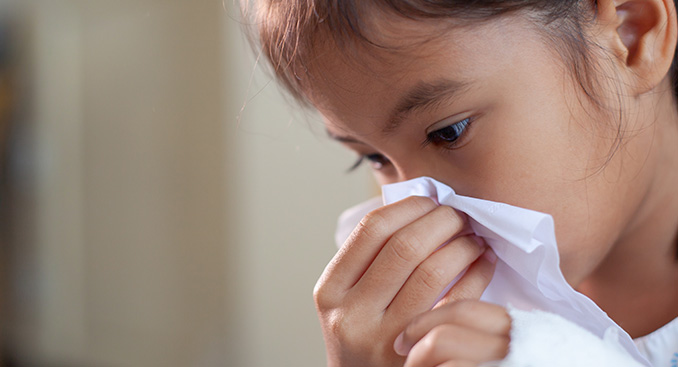Combating Cold and Flu: Prevention and Separating Fact from Fiction

As cooler weather pushes people together indoors, cases of cold and flu in children increase. Even though these two common viruses are unrelated, people often confuse them. Here’s the difference:
- A cold is the general term for hundreds of viruses, including rhinovirus, which can occur year- round but peaks in winter months. Symptoms such as a runny nose or mild cough come on gradually and generally center around the upper airway, says Benjamin Minick, MD, a pediatrician with TriHealth.
- Influenza, more commonly called flu, is a more potent virus, he says. It typically comes on abruptly, causing fever, chills, body aches, sore throat and headache all at once. The virus mutates from year to year, but flu season generally runs from October through May, with peak season between December and February.
Dr. Minick emphasizes that your child’s best defense against these widespread illnesses is prevention.
5 Ways to Prevent the Spread of Cold and Flu
Parents can help their children stay healthy by following these tips:
- Handwashing is the number one way to avoid getting sick and spreading germs to others. Wash hands before and after you eat, as well as before preparing food. Scrub your hands for at least 20 seconds with soap and rinse with clean water. Use a hand sanitizer if soap and water aren’t available.
- To prevent flu, get children over age 6 months vaccinated with the flu vaccine. “The vaccine prevents flu and serious complications of flu,” Dr. Minick says. “A 2017 study of kids shows that it saves lives and lowers the risk of hospitalization. If we could have 90 percent of people vaccinated for flu, prevalence would go down dramatically.” He says less than half of children are getting vaccinated. Ideally, get your child vaccinated in October; later is better than not at all.
- Stay home with a fever. If your child has a fever, this is the most contagious phase of the illness. Keep your child home until the fever is gone. Keep your child away from others who have fever.
- Don’t share drinks, even if you’re healthy. It’s possible to pass germs before you know you are sick.
- Avoid people who are coughing and sneezing, and limit your contact with others when you are coughing or sneezing. Both colds and flu are spread by droplets released into the air or onto hands.
Separate Fact from Myth
MYTH: The flu shot can give you the flu.
FACT: “All immunizations cause your body’s immune system to become activated,” Dr. Minick says. “You may feel a little more tired or achy, but this is a sign your immune system is working—it’s not the flu.”
MYTH: Antibiotics can cure colds and flu.
FACT: Antibiotics kill bacterial infections, not viruses like cold and flu. There’s no cure for a virus, but you can make your child feel better with acetaminophen (Tylenol®) or ibuprofen (Advil®). Have your child drink plenty of water. “Children who get the flu don’t generally need Tamiflu®, a medicine that helps the immune system get rid of the illness quicker. The flu vaccine is a much better remedy to minimize flu symptoms,” Dr. Minick says.
MYTH: My child is very healthy, so he doesn’t need a flu shot.
FACT: Anyone can get the flu—even healthy people. Getting a flu shot protects both your child and others around him—babies, elderly grandparents and others at greater risk of serious complications from flu.
MYTH: You can catch the flu or a cold by being outside in cold air without a coat or with wet hair.
FACT: Only a virus can give you a cold or flu.
MYTH: Vaccines aren’t safe.
FACT: “The truth is that they are safe, they are rigorously tested and they save lives,” Dr. Minick states. “I’ve never seen anyone die from a vac- cine, but I’ve seen many cases of people dying from preventable illnesses for which we have vaccines.”